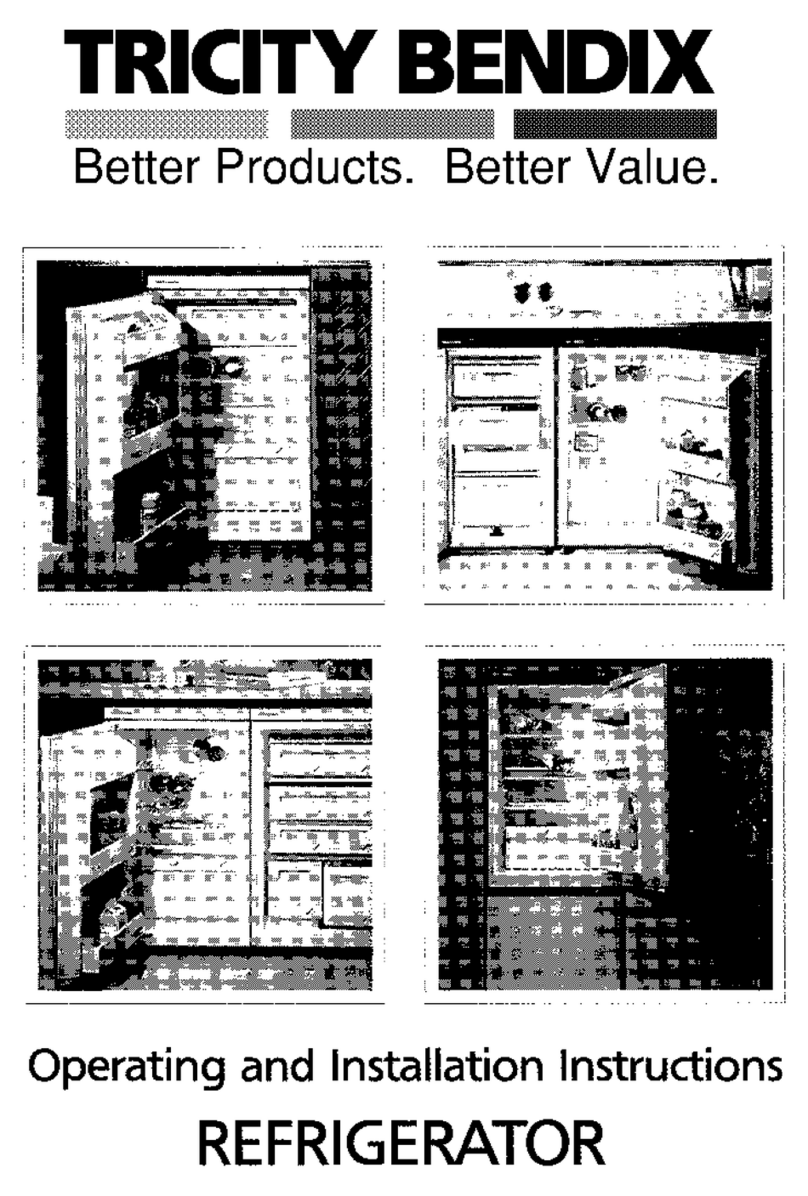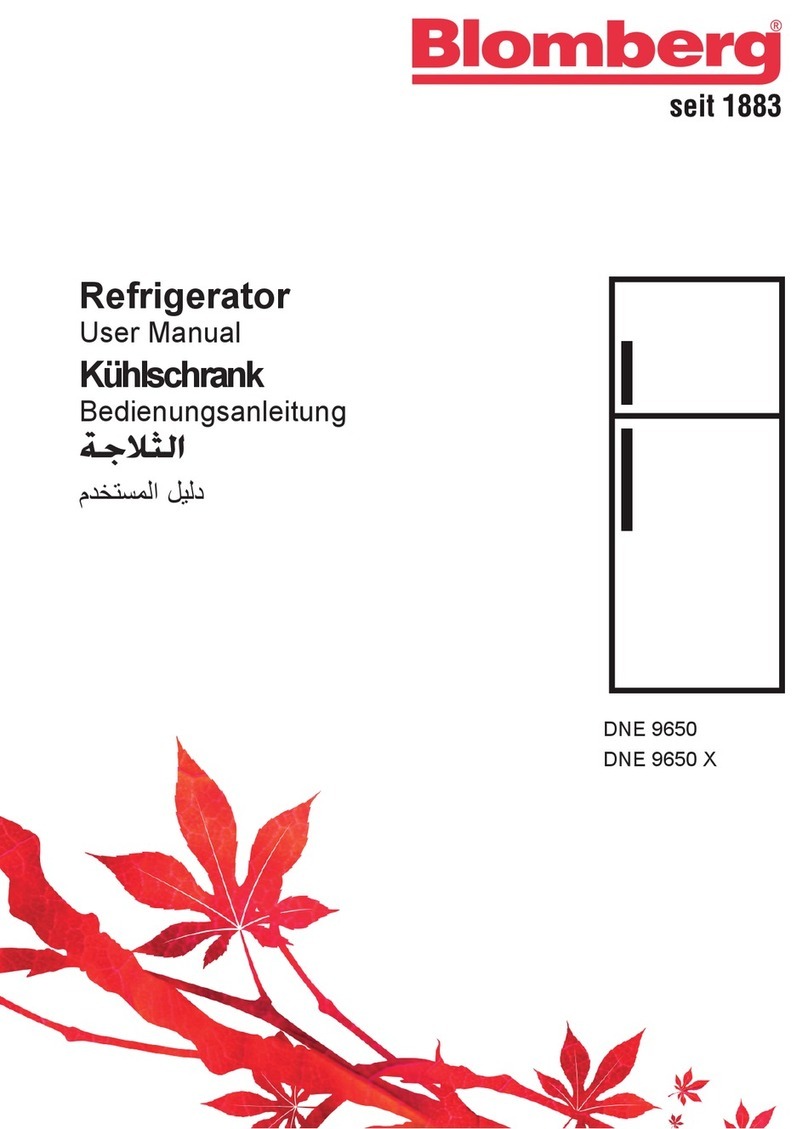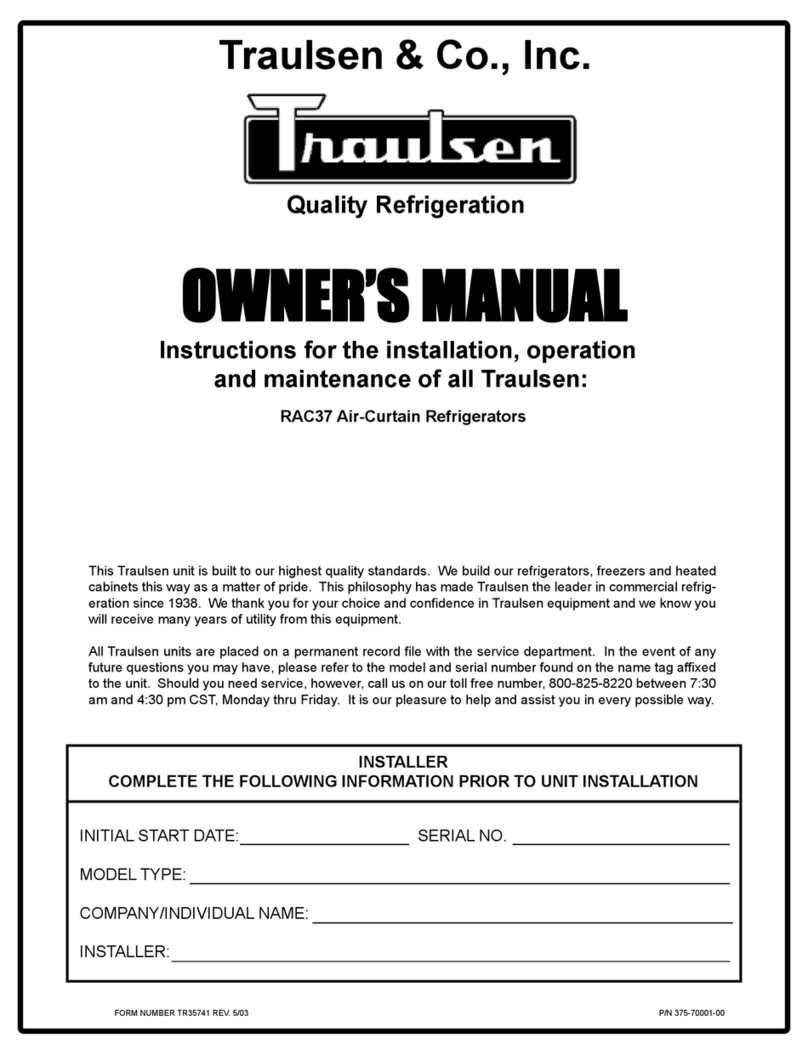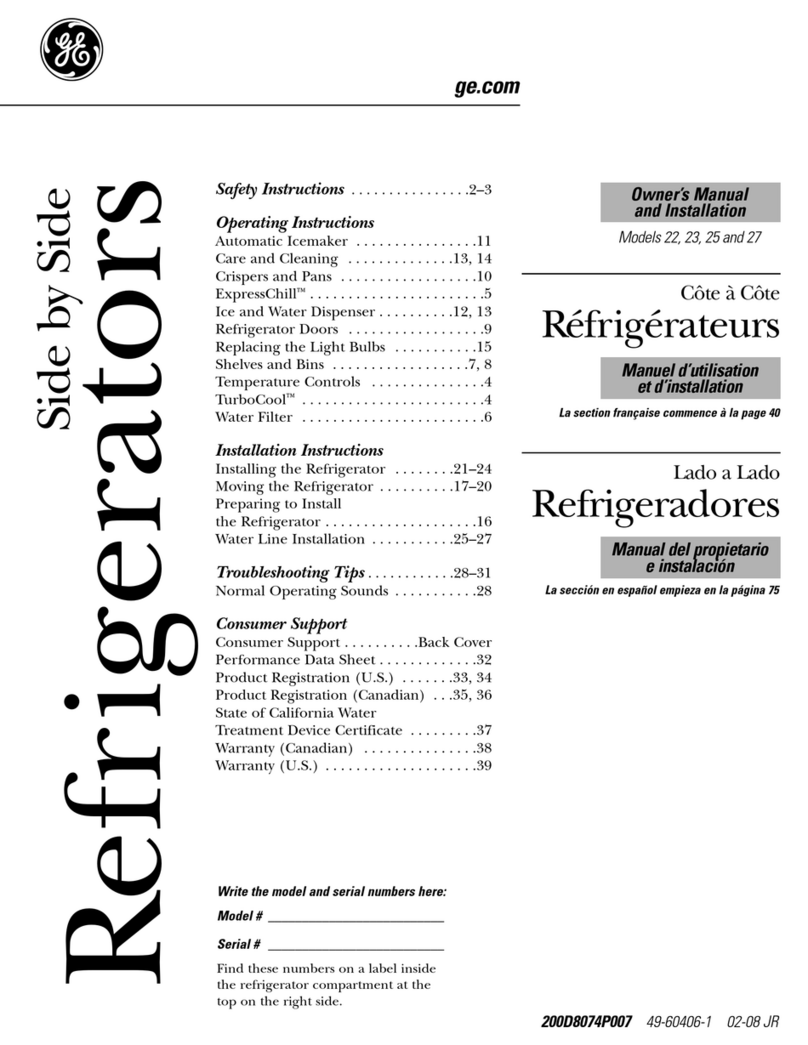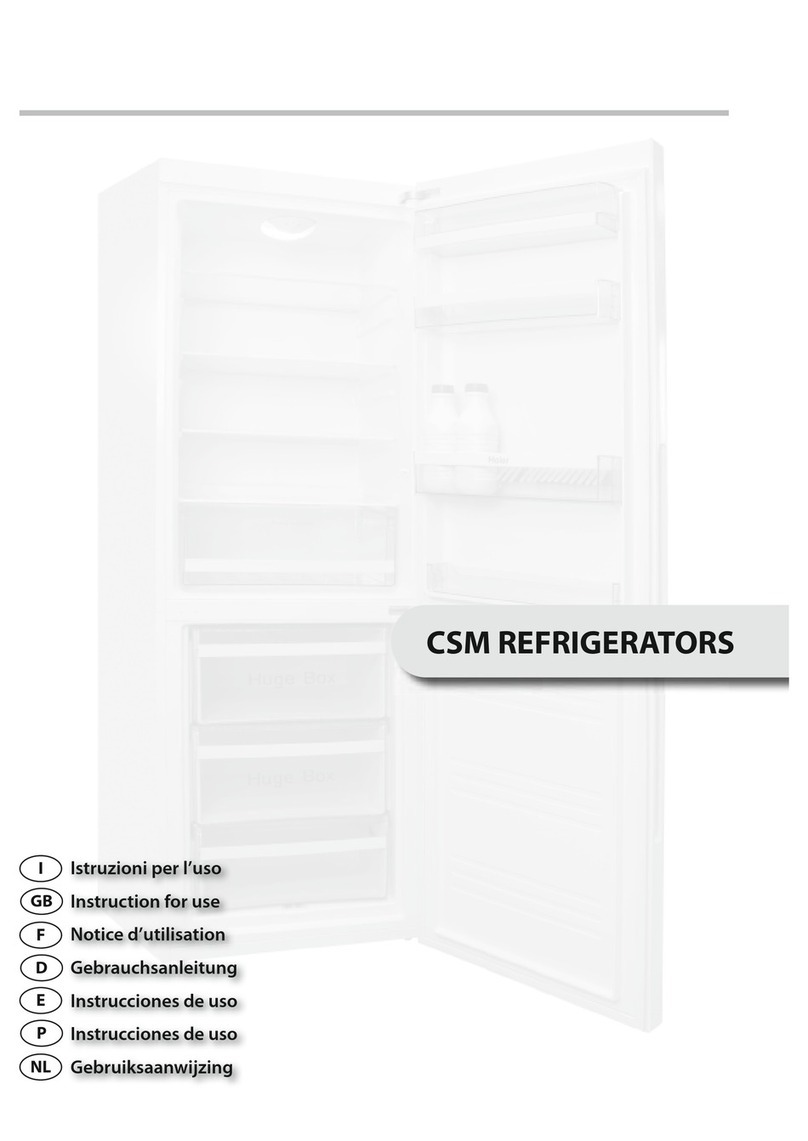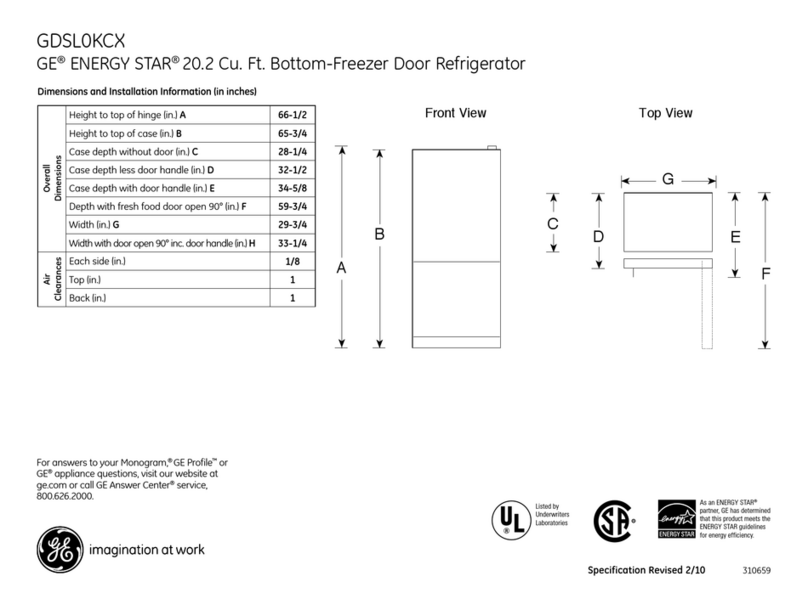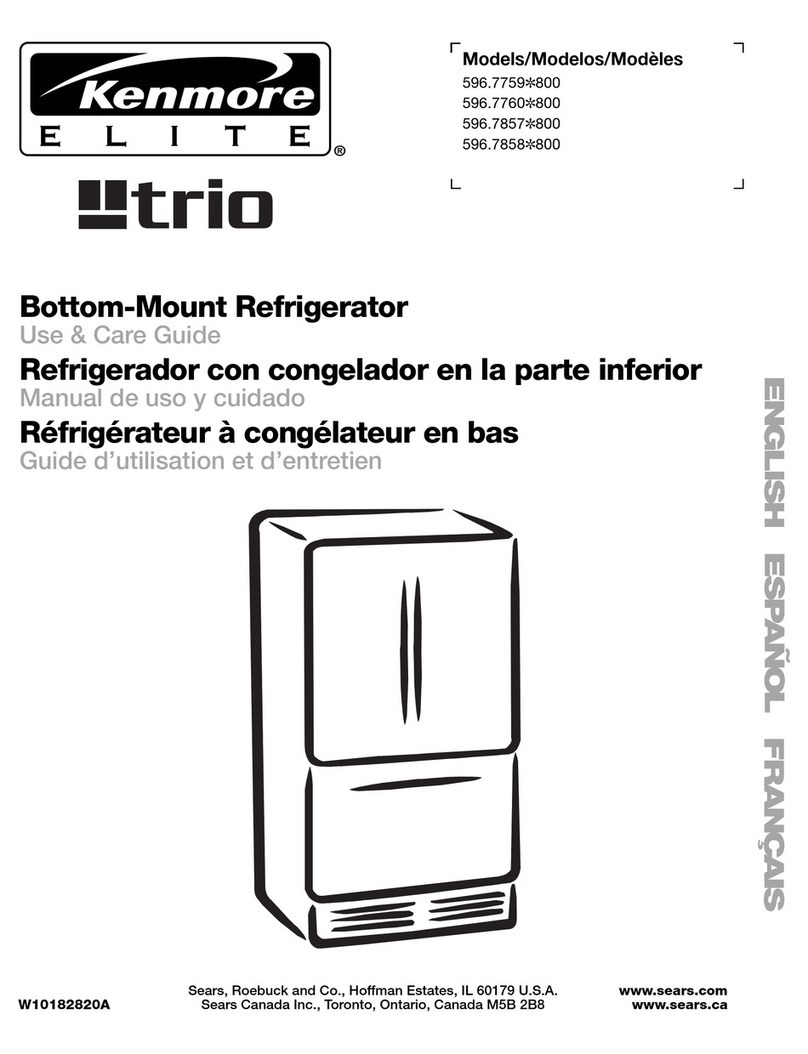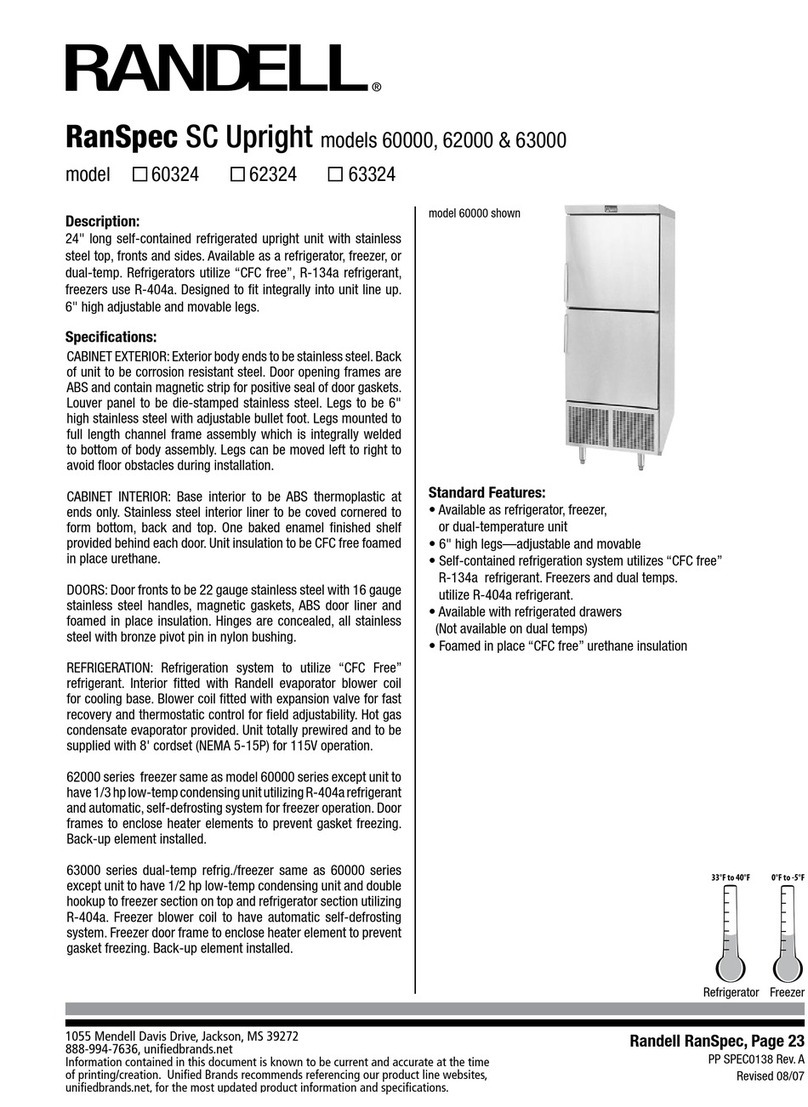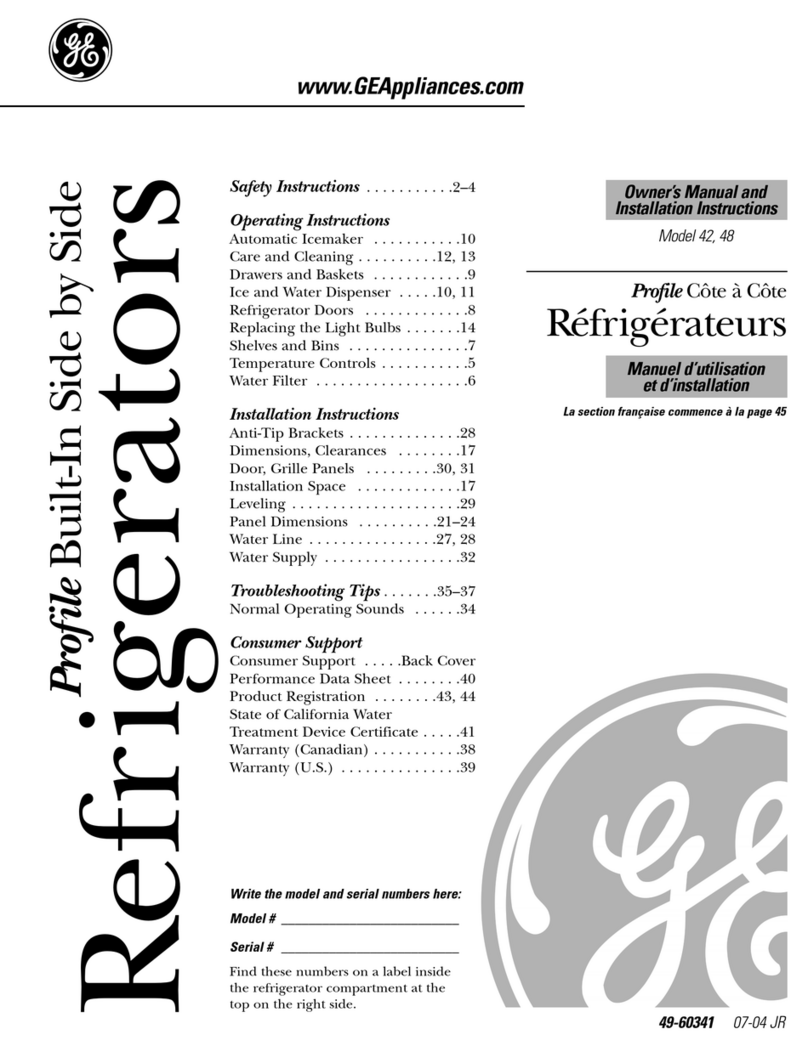SIGURO SGR-BF-J140W Operating instructions

SGR-BF-J140W
SGR-BF-J140S
SGR-BF-J140Y
Refrigerator wih Bottom Freezer
Refrigerator wih Bottom Freezer
Kühlschrank mit Gefrierfach unten
Lednice s mrazákem dole
Chladnička s mrazničkou dole
Alulfagyasztós hűtőszekrény
EN Translation of the operating instructions from the original language.
DE Übersetzung der Bedienungsanleitung aus der Originalsprache.
CZ Návodkpoužitívoriginálnímjazyce.
SK Prekladnávodunapoužitiezoriginálnehojazyka.
HU Ahasználatiutasításfordításaeredetinyelvről.

ENGLISH 4
Safety information 4
Transport 8
Before use 8
Use 10
Cleaning and maintenance 13
Troubleshooting 14
Choosing door hinge side 15
DEUTSCH 25
Sicherheitshinweise 25
Transport 29
Vorbereitung vor der verwendung 29
Verwendung 31
Reinigung und wartung 34
Problemlösung 36
Änderung der öffnungsrichtung der tür 37
ČESKY 47
Bezpečnostní informace 47
Přeprava 51
Příprava před použitím 51
Použití 53
Čištění a údržba 56
Řešení problémů 58
Otočení směru otevírání dvířek 59
SLOVENSKY 68
Bezpečnostné informácie 68
Preprava 72
Príprava pred použitím 72
Použitie 74
Čistenie a údržba 77
Riešenie problémov 79
Otočenie smeru otvárania dvierok 80
MAGYAR 90
Biztonsági információk 90
Szállítás 94
Előkészület a használathoz 94
Használat 96
Tisztítás és karbantartás 99
Problémamegoldás 101
Az ajtónyitás irányának a megváltoztatása 102

2
1
3
4
5
7
8
9
10 11
6
12 13 14

EN
EN - 4
Thank you for purchasing a SIGURO appliance. We thank you for
your trust and are proud to introduce on the following pages the
device, its functions and uses.
We believe in a fair and responsible company, and therefore we only work
with suppliers who meet our strict criteria to protect the interests of employ-
ees, prevent their abuse and fair working conditions.
If you need help with extensive maintenance or repair of the product’s inter-
nal workings, contact the vendor’s helpline or our authorized service center
at siguro@alza.cz. For your convenience in solving any problems with the
product, we have unied these contact points so that the contacts above can
also be used for warranty claims and post-warranty service.
SAFETY INFORMATION
Please read this manual carefully before
use and keep it for future reference.
1. Children aged at least 8, persons with physical, sensory or mental
impairment, and the untrained or inexperienced may use this appliance
with instruction or supervision in its safe use, provided they understand
the potential dangers.
2. Children must not play with the device.
3. Cleaning and user maintenance must not be performed by children
without supervision.
4. If the power cord is damaged, it must be replaced by the manufacturer,
its service agent or similarly qualied persons in order to avoid a
dangerous situation.
WARNING: RISK OF FIRE!
5. Children aged 3 to 8 may store food in and remove it from the appliance.
6. WARNING: Always keep clear all vents found on the appliance body and
frame.
7. WARNING: Do not use mechanical devices or means other than those
recommended by the manufacturer to speed up the defrosting process.
8. WARNING: Do not damage the cooling circuit.
9. WARNING: Do not operate electrical appliances inside the food storage
compartment, except those cleared for such use by the manufacturer.
10. Do not store potentially explosive substances, such as ammable-
propellant sprays, in the appliance.
ENGLISH

EN
EN - 4 EN - 5
ENGLISH
11. This appliance is designed for home and light commercial use, including:
‐ kitchenettes in stores, ofces and other workplaces;
‐ guest appliances in hotels, motels and other residential environments;
‐ bed & breakfast establishments;
‐workplace cantinas and similar non-commercial uses.
12. This appliance is designed as free-standing. It is not designed for built-in
or mounted use.
13. Use this appliance only according to the instructions in this manual.
For safe food storage, only use the appliance in accordance with the
instructions in this manual.
14. Follow these recommendations to avoid contamination of stored food:
‐ Leaving the door open for long periods of time can signicantly warm
the storage compartment.
‐Clean food contact surfaces and accessible drainage systems regularly.
‐Clean water containers that have not been used for 48 hours or longer.
Flush the appliance’s water circuit when the water supply has been
dry or disconnected for 5 days or longer.
‐ Store raw meat and sh in the refrigerator in suitable containers, so
that they do not come into contact with or drip on other foods.
‐Freezer spaces rated two stars are suitable for storing pre-frozen food,
storing and making ice cream, and making ice cubes.
‐Spaces rated three stars or less are not suitable for freezing fresh food.
‐Before prolonged disuse, turn off, defrost, clean and dry the appliance,
then leave the door open to prevent mold from forming inside.
15. WARNING: Place the appliance so as to keep the power cord from
snagging or otherwise becoming damaged.
16. WARNING: Do not keep multi-plug sockets or extension cords
immediately behind the appliance.
17. WARNING: Any servicing or repair involving the removal of the outer
shroud is dangerous when not performed by a qualied technician. To
avoid electrocution, do not attempt to repair the appliance yourself.
18. Volatile liquids and gases may leak from their containers in low
temperatures.
19. Never place carbonated drinks, bottled or canned, in the freezer.
20. Ice cream can cause frostbite if consumed immediately upon removal
from a freezer. It is recommended to let it thaw for at least 5 minutes.
21. Do not touch the food in the freezer with wet hands. This way you can
avoid frostbite and skin damage.
22. Keep children away from the appliance’s controls.
23. The appliance is heavy. Take extra care when handling it. Ideally get a
second person to help you.
24. Modifying the appliance in any way is dangerous.
25. The LED lighting in the food compartment may only be replaced by an
authorized service technician. Never replace the light yourself.
26. WARNING: Cooling appliances, particularly class-I combined cooler-
freezers, may not work properly (the temperature in the frozen food
compartment may rise above freezing) when exterior temperatures
remain below the lower limit of the appliance’s operating temperature

EN
EN - 6
range for prolonged periods.
27. WARNING: If the door or lid is equipped with a lock, the keys to the lock
must be kept away from children and away from the appliance, to avoid
the risk of children locking themselves in.
28. WARNING: The coolant and insulation materials used in this appliance
require special disposal procedures.
Electrical Connection
1. This appliance may only be powered from properly grounded mains
outlets supplying 220–240 V ~ 50 Hz. Before plugging the appliance
in, make sure the outlet voltage matches the values specied on the
appliance rating plate.
2. This appliance may be used with a voltage converter.
3. The power cord should be routed behind the appliance. It should be out
of the way and laid on the oor to prevent accidents.
4. Do not unplug the appliance by pulling on the power cord. Pull on the
plug instead.
5. Avoid using extension cords; these may degrade the appliance’s
performance. If the supplied power cord is too short for your needs, it
is best to have a mains socket installed closer to it (by a professional
electrician).
Climate Class
The appliance’s climate class is indicated on its rating plate. The climate class deter-
mines the ambient temperatures in which the appliance was designed to operate.
Climate class Ambient temperature
range
SN 10 – 32 °C (50 – 90 °F)
N 16 – 32 °C (60 – 90 °F)
ST 16 – 38 °C (60 – 100 °F)
T 16 – 43 °C (60 – 110 °F)
Note:
The appliance’s interior temperature setting should be adapted to the
climate class, ambient temperature, opening frequency, etc.
Operating the appliance in conditions outside its rated climate class may
degrade its performance.
Lock
If the door or lid is equipped with a lock, the keys to the lock must be kept away from
children and away from the appliance, to avoid the risk of children locking themselves
in.
When disposing of the appliance, destroy the lock to prevent its further use.
R600a Refrigerant
The R600a refrigerant and cyclopentane insulation used in this appliance are safe

EN
EN - 6 EN - 7
for the enviornment and the ozone layer, and have minimal global warming impacts.
However, R600a is a ammable substance. When transporting, installing or otherwise
handling the appliance, take care not to damage the cooling circuit, to prevent liquid
or gaseous refrigerant leaks. In the event the cooling circuit is damaged and liquid or
gaseous refrigerant leaks into the environment, immediately douse any open ame in
the area and open all available windows.
Appliances containing refrigerants require professional, environmentally safe disposal.
Improper disposal may cause injury, re, or other hazardous situations. Refrigerants
may only be handled by qualied personnel certied to do so. Before disposal, check
the cooling circuit for potential damage.

EN
EN - 8
Overview
1 Thermostat
2 Fridge shelves
3 Vegetables tray cover plate
4 Fruits and vegetables tray
5 Freezer trays
6 Adjustable feet
7 Fridge door
8 Door-mounted trays
9 Freezer door
10 Ice maker
11 Egg tray
12 Door handle (2 pc)
13 Bolt (4 pc)
14 Cover (4 pc)
3
TRANSPORT
The appliance must always be transported upright. The packaging is meant to pro-
tect the appliance in transit; avoid damaging it during transport.
If there is no choice but to transport the appliance on its side, place it so that the door
cannot open, to prevent damage to it. Restore the appliance to upright position as
soon as possible. After spending time horizontal, the appliance must remain upright
for at least 4 hours before being plugged in and powered on, to give the refrigerant
time to settle. Failing to do so risks permanent damage to the appliance, as well as a
hazardous operating situation.
The appliance is heavy; we recommend at least two people handle it. Avoid carrying
the appliance by the upper frame, the door, etc.
BEFORE USE
Unpacking
Carefully unpack the appliance and remove any tape, stickers, foil, etc.
Selecting a Spot
Place the appliance on a hard, level surface within reach of the mains socket. To avoid
excess noise and vibration, do not install on carpets, rugs or similar ooring.
The appliance is designed for domestic, indoor use. Do not install outside or in any
spot exposed to rain, snow, moisture or other weather effects.
Level the appliance if necessary. Use the adjustable feet. Screw the feet in or out to
change their height. Leveling is important to prevent excessive vibration and noise.
The refrigerant mass is specied on the appliance rating plate.
Provide adequate space for air to circulate around the appliance: at least 50 mm (2 in)

EN
EN - 8 EN - 9
on all sides and above – see gure below.
Provide adequate clearance in front to allow opening the door.
A
B
C
D min= 0
E min=50
F
G
H
F F
F
A B C D E F G H I
500
mm
560
mm
1422
mm
min.
50 mm
min.
50 mm
min.
50 mm
1000
mm
1060
mm
135°
Do not place the appliance near stoves, heaters, or other heat sources. Avoid exposing
the appliance to direct sunlight.
Do not install in damp or dusty rooms. Do not cover the vents.
The appliance may interfere with radio and television signals. It should be placed suf-
ciently far from their receivers.
Handle Installation
When installing handles, proceed as follows:
1. On the side where the handle is to be mounted, remove the bolthole covers.
2. Hold the handle against the door edge so that the bolt holes in the handle align
with those in the door.
3. Use the supplied bolts to bolt on the handle.
4. Mount the bolthole covers in the bolt holes vacated by moving the handle from
the other side.

EN
EN - 10
Cleaning Before Use
Before rst use and after prolonged disuse, clean the food compartments and trays
with water, either pure or with some white vinegar. Do not use detergents, solvents,
hydrocarbon cleaners, etc. These might irreparably damage the nish.
Settle-Down Time
Once installed and cleaned, wait at least 1 hour before plugging the appliance in. This
will give the refrigerant time to settle in the cooling circuit.
Plugging In
Plug the power cord into a properly grounded mains socket. The appliance must be
grounded. The voltage specied on the appliance rating plate must match your mains
voltage. In case of doubt, consult your power company or a qualied electrician.
USE
Setting Fridge Temperature
Temperature setting is by thermostat. Turn the thermostat knob to set temperature
from “1” (warmest) to “7” (coldest).
Turning the thermostat to “0” turns off the appliance.
The table below suggests thermostat settings for various ambient temperature
ranges. These are only indicative; you should set the thermostat to whatever ts your
needs.

EN
EN - 10 EN - 11
Ambient tem-
perature
Thermostat setting
29 – 38 °C (85 –
100 °F)
2 to 4
21 – 28 °C (70 –
85 °F)
4
16 – 20 °C (60 –
70 °F)
4 to 6
Setting the thermostat to “7” will run the compressor continuously regardless of tem-
perature. This setting is suitable for rst use after purchase or a long period of disuse,
or when cooling or freezing larger amounts of fresh food. We do not recommend
keeping the thermostat at “7” permanently. This may lead to excessive icing or partial
freezing of the contents of the fridge compartment.
The table below gives the approximate temperatures in the freezer and fridge com-
partments at different thermostat settings.
Setting Fridge (± 2 °C) Freezer (± 2 °C)
1 9 -14
2 7 -16
3 5 -17
4 4 -18
5 2 -19
6 2 -20
7 0 -22
Note:
The appliance may not work properly when sited in a particularly warm
room or when the door is frequently opened.
Open Door Warning
If the fridge door remains open for more than 60 seconds, the LED lights will ash
three times, then glow for 5 seconds. This will repeat until the door is closed.
Storing Food
Air cooled by the compressor circulates throughout the appliance interior, making
different areas of the interior somewhat different temperatures, and therefore better
suited for storing different kinds of food.
Store foodstuffs in their original packaging or in airtight containers to prevent odor
and contamination of the food.
Use the fridge area to store non-frozen foods, such as cooked meals, beverages, eggs,
dairy, etc. Use the tray to store fruits and vegetables. Use the freezer area to store ice
cream, frozen foods, etc.

EN
EN - 12
Suggested Food Placement
Door-mounted trays Beverages, jams, ketchup, etc.
Fruits and vegetables tray Fruits, vegetables, refrigerator-safe herbs, etc.
Middle shelf Dairy, eggs
Top shelf Foods eaten raw, sausages, ready-made meals, etc.
Freezer trays Food suitable for long-term storage
Bottom tray: raw meat, poultry, sh
Middle tray: frozen vegetables, fries
Top trays: ice cream, frozen fruits, frozen bread
Ice maker: Fill with clean potable water and set in the freezer to make ice cubes.
Shopping Tips
• Reduce waste by only buying as much as you know you can use.
• Always check the “best before” date printed on the packaging.
• Check packaging integrity.
• Check appearance and smell, particularly with fruits and vegetables. Only buy
fruits and vegetables of awless appearance.
• Save frozen foods for the last items you take when shopping, and keep them in
insulated bags on the way home.
• Always check the integrity of the packaging on packaged foods.
• The freezer can only freeze a certain weight of fresh food per 24 hours of operation.
You can nd this value on its rating plate. Minimize door opening when freezing
fresh foods.
• Before loading fresh food to be frozen, and particularly before loading already-
frozen food, always check that the interior is sufciently cold. Otherwise, frozen
food might thaw before the interior cools to freezing.
• When freezing freshly prepared food, let it cool to room temperature before
loading.
• Pack fresh foods in packaging sold for the purpose. Label the packages with food
name, weight, and date of freezing. Packets should be dry when loaded.
Food Storage Tips
• Regularly check the condition of all stored food; use foodstuffs before they go bad.
• Place the most frequently used items up front to reduce rummaging. This will
allow you to close the door again sooner.
• Do not re-freeze defrosted or partly defrosted food.
• Defrosted meat should be heat-treated, not eaten raw.
• Do not overload the fridge. Keep some amount of free space between stored items
to allow the cold air to circulate throughout.
• Let food cool to room temperature before loading in the fridge.
• Minimize door opening frequency.
• Only store foods intended for refrigeration / freezing. Some foods, particularly
certain fruits and vegetables, do not need to be refrigerated.
• Store food in original packaging or airtight containers to keep it from becoming
contaminated or developing a foul odor.
• Do not place food packets in direct contact with the interior liner of the freezer

EN
EN - 12 EN - 13
area. Do not place water-rich foods close to the freezer area back plate to keep
them from freezing stuck.
• Do not load liquid-lled glassware or canned beverages into the freezer. Water-
based liquids increase in volume as they freeze, potentially destroying inexible
containers such as glass or can aluminum.
CLEANING AND MAINTENANCE
Keep the appliance clean. Food residue may accumulate in the fridge and emit a foul
odor. We recommend cleaning the shelves and trays at least once a month.
Warning:
Do not immerse the appliance or its power cord in water or other liquids.
Routine Maintenance
Remove all food from the fridge (not the freezer), then remove the shelves and trays.
Wash them in warm water with some dish detergent; rinse and wipe dry.
Clean the fridge interior with a clean towel slightly dipped in clean, lukewarm water.
Wipe dry.
Wipe the door gasket with a soft cloth slightly dipped in warm water.
Wipe the appliance exterior with a soft cloth slightly dipped in warm water with some
dish detergent.
Dust off the back of the appliance. You may also use a vacuum cleaner with a brush
attachment on low power.
To prevent water from de-icing from overowing into the fridge interior, regularly
clean the drainage port found at the rear of the fridge section. Use the supplied clean-
ing tool and the procedure shown in the gure below.
Warning:
Do not clean with harsh detergents, alkali, solvents, hydrocarbon
cleaners, etc. Only use a soft sponge or towel. Do not use scrapers or
other hard tools that might scratch the nish.
Warning:
Do not clean with a steam cleaner.
De-Icing
During use, certain parts of the appliance build up ice. This needs to be removed

EN
EN - 14
regularly to prevent deterioration of the appliance’s function and cooling and power
efciency.
Proceed as follows:
5. Turn off the appliance. Set the thermostat to “0”, then unplug the appliance from
the mains.
6. Remove all trays. Pack food in old newspapers or other insulation and store in a
cool place.
7. Keep the door open. Place a suitable water catchment vessel in the interior.
8. For faster de-icing, you may place a bowl of hot water inside as well.
9. You may also use a plastic scraper to manually remove ice.
10. Once the freezer has been de-iced, wipe it dry with a clean towel.
11. Plug the appliance back in and set the thermostat to your preferred setting. We
recommend keeping the thermostat at 7 for the rst 12 hours after de-icing.
12. Reload trays with food, then return them into the appliance.
Warning:
Never de-ice with metal tools, hair driers, fans, or other power tools.
Lighting Replacement
The LED lighting in the food compartment may only be replaced by an authorized
service technician. Never replace the light yourself. Contact an authorized service
centre instead. The light source installed in this appliance is rated G on the EU energy
efciency scale.
Long-Term Power-Down
When not using the appliance, keep it unplugged from the mains. Clean the interior,
including the freezer, as described above.
Leave the door open to prevent a stale odor from developing inside.
TROUBLESHOOTING
Problem Cause Solution
Fridge not working Thermostat at “0” Turn thermostat away
from “0”.
Plugged in badly or not
at all
Plug appliance in properly.
Blown or tripped fuse Check fuse box.
Mains socket damaged Contact a qualied elec-
trician.
Interior too cold Low temperature setting
or Quick Freeze on
Change temperature
setting / turn off Quick
Freeze.

EN
EN - 14 EN - 15
Problem Cause Solution
Poor cooling performance Thermostat setting too
warm
Set thermostat to colder.
Door open too long Reduce time door is open.
Hot food or too much food
loaded
Check food to identify
items that may not need
refrigeration. Let food cool
down before loading.
Appliance sited in direct
sunlight or near a heat
source
Move appliance out of di-
rect sunlight / away from
heat source.
Unusual noises Appliance poorly leveled Use adjustable feet to
re-level appliance.
Appliance touches wall or
other object
Move appliance away from
wall / object.
Part of appliance back
touches wall, power cord,
or other object
Rearrange appliance so its
back touches nothing.
Water on oor Clogged drainage port Clean drainage port.
Side panel hot Heat released by condens-
er
This behavior is normal.
If the problem is not listed in the table above or if it persists, turn off the appliance,
unplug it from the mains, then contact an authorized service center.
CHOOSING DOOR HINGE SIDE
We recommend getting a second person to help with switching the door hinge from
one side to the other. You will need a at-head screwdriver, Phillips-head screwdriver,
and a wrench.
To remove the door, you will need to tilt the appliance back somewhat. We recom-
mend placing the appliance so that it can be tilted back against a wall, to prevent it
from falling over during work.
Make sure not to lose any of the parts being removed; you will need all of them later.
To avoid damage to the cooling circuit, do not lower the appliance into a horizontal
position.
1. Check that the appliance is unplugged.

EN
EN - 16
2. Use a at-head screwdriver to pop off the top hinge
cover plate.
3. Unbolt the top hinge.
4. Use the at-head screwdriver to pop off the bolthole
cover on the other side.
5. Move the hinge pin cover from the left to the right side
of the appliance. Then lift off the top door and set it
down on a soft surface to avoid scratching.
6. Unbolt the middle hinge, then lift off the bottom door
and set it down on a soft surface to avoid scratching.
7. Move the middle hinge bolthole covers from left to right.

EN
EN - 16 EN - 17
8. Carefully tilt the appliance back, then unbolt the bottom
hinge and remove the adjustable feet.
9. Release and remove the bottom hinge pin. Mirror-ip the hinge, then use wrench
to screw the hinge pin back in.
10. Mount the bottom hinge on the left and the adjustable
foot backplate on the right. Then screw in both feet.
11. Set the appliance upright and attach the bottom door
to the bottom hinge. Make sure the bottom hinge pin
sits well in the door’s pinhole. Move the middle hinge
bolthole cover from left to right.
12. Install the middle hinge.

EN
EN - 18
13. Attach the top door and install the top hinge.
14. Attach the top hinge bolthole cover and cover plate.
15. Check the door seal for signs of deformation. If
deformed, remove the seal band, turn it around, then
reinstall it.
Note:
When remounting both doors, check that their top edges align with the
appliance body. If the door is mounted poorly aligned, the door gasket is
likely to lose its seal, degrading cooling performance.

EN
EN - 18 EN - 19
Product Information Sheet
COMMISSION DELEGATED REGULATION (EU) 2019/2016 with regard to energy labelling of refrigerating
appliances
Supplier's name or trade mark: Siguro
Supplier's address: PL - SIGURO, Jankovcova 1522/53 17000 Praha Holešovice Česká republika
Model identifier: SGR-BF-J140W
Type of refrigerating appliance:
Low-noise appliance: No Design type: freestanding
Wine storage appliance: No Other refrigerating appli-
ance: Yes
General product parameters:
Parameter Value Parameter Value
Height 1 422
Width 500
Overal dimensions
(millimetre) Depth 560
Total volume (dm³ or l) 173
EEI 80 Energy efficiency class D
Airborne acoustical noise emis-
sions (dB(A) re 1 pW) 40 Airborne acoustical noise
emission class C
Annual energy consumption
(kWh/a) 155 Climate class: temperate, subtropi-
cal
Minimum ambient tempera-
ture (ºC), for which the refrig-
erating appliance is suitable
16
Maximum ambient tem-
perature (ºC), for which
the refrigerating appliance
is suitable
38
Winter setting No
Compartment Parameters:
Compartment parameters and values
Compartment type Compartment Vol-
ume (dm³ or l)
Recom-
mended
tempera-
ture setting
for opti-
mised food
storage (ºC)
These set-
tings shall
not con-
tradict the
storage
conditions
set out in
Annex IV,
Table 3
Freezing
capacity
(kg/24h)
Defrosting type
(auto-defrost=A,
manual defrost=M)
Pantry No - - - -
Page 1 / 2

EN
EN - 20
Wine storage No - - - -
Cellar No - - - -
Fresh food Yes 121,0 - - A
Chill No - - - -
0-star or ice-making No - - - -
1-star No - - - -
2-star No - - - -
3-star No - - - -
4-star Yes 52,0 - - M
2-star section No - - - -
Variable temperature
compartment - - - - -
For 4-star compartments
Fast freeze facility No
Light source parameters:
Type of light source LED
Energy efficiency class -
Minimum duration of the guarantee offered by the manufacturer: 36 months
Additional information:
Weblink to the manufacturer's website, where the information in point4(a) Annex of Commission Regulation (EU)
2019/2019 is found: www.siguro.cz
Page 2 / 2
This manual suits for next models
2
Table of contents
Languages:
Popular Refrigerator manuals by other brands
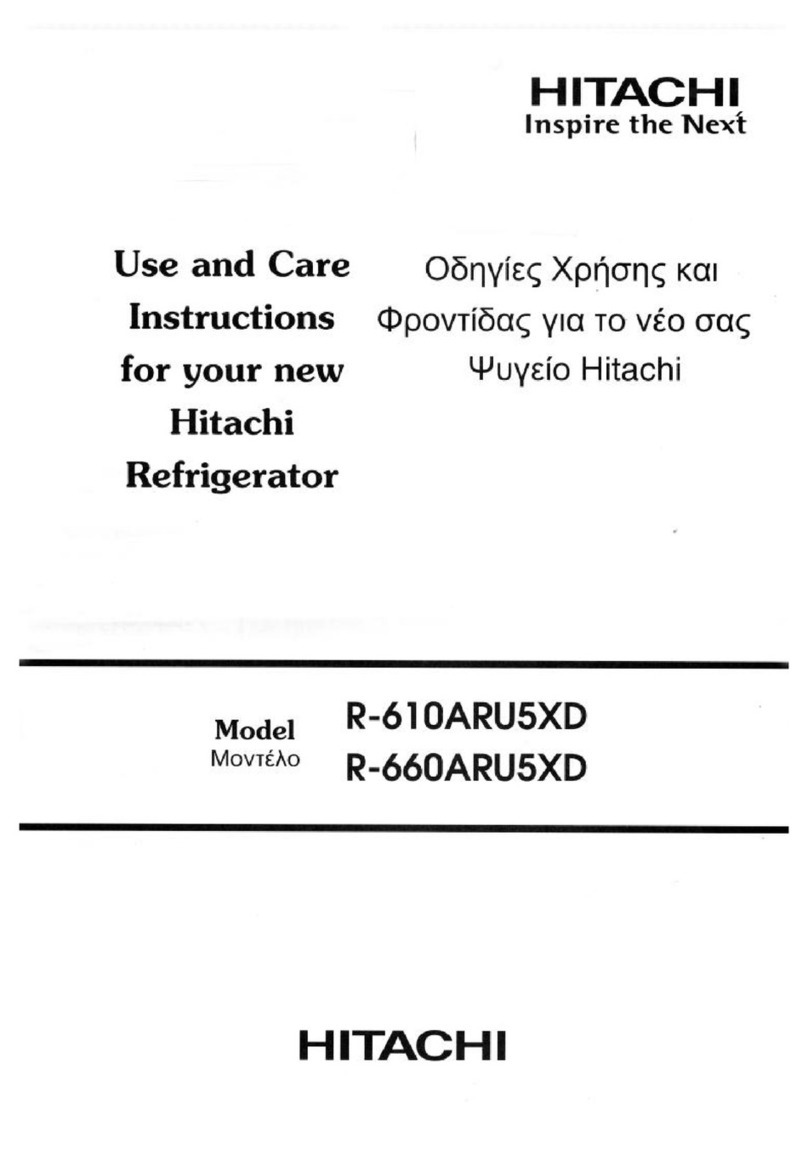
Hitachi
Hitachi R-660ARU5XD Use and care instructions

Whirlpool
Whirlpool Gold GS6NHAXVS supplementary guide

Kernau
Kernau KFRC 18151.1 NF X Instruction booklet

Frigidaire
Frigidaire FRT17G5JS parts catalog
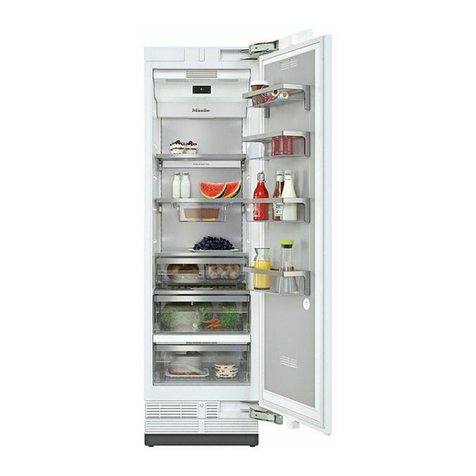
Miele
Miele K 2601 V Operating and installation instructions

Traulsen
Traulsen RRI332LPUT-FHS Specification sheet


